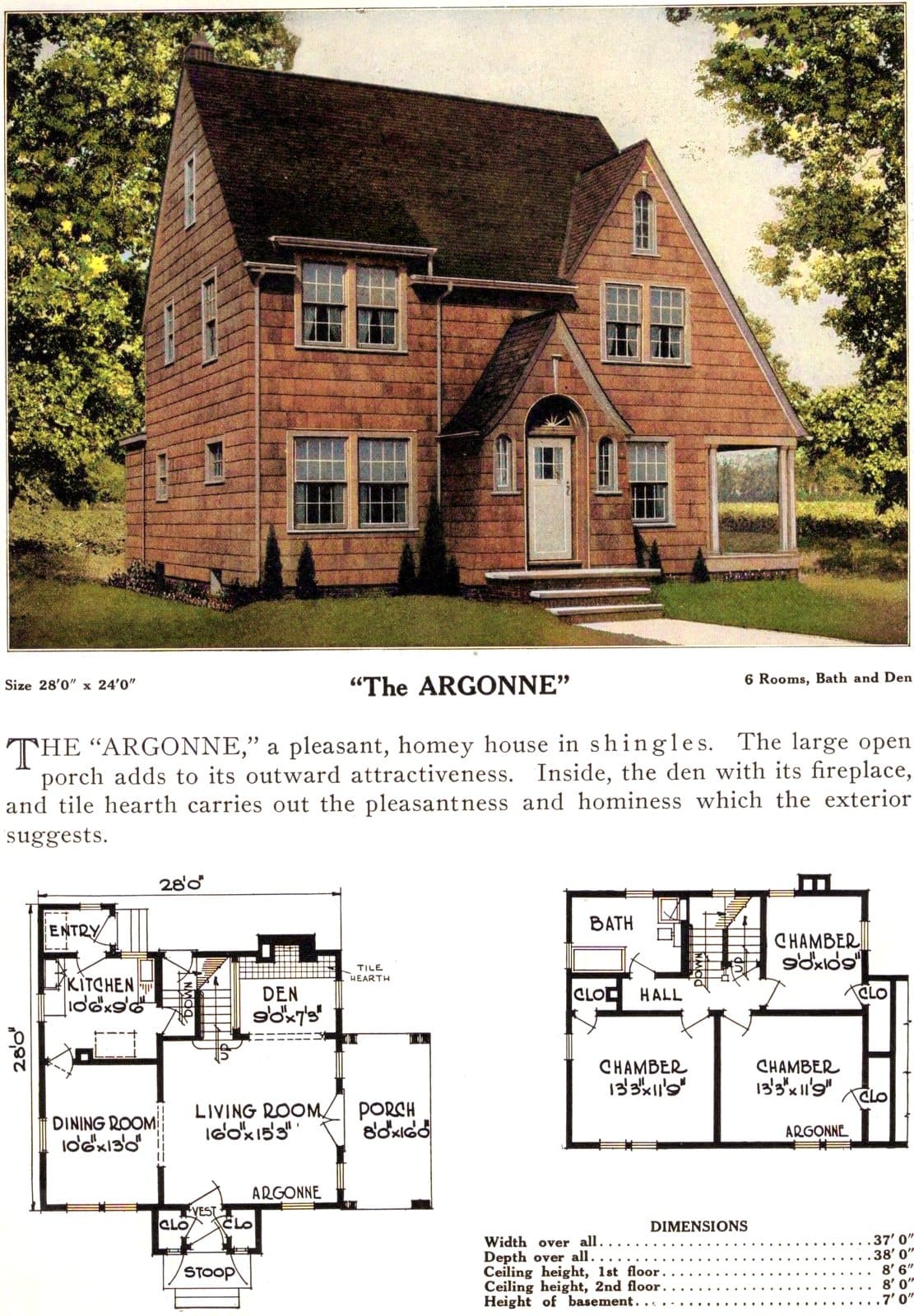- Radford, William A. (Author)
- English (Publication Language)
- 176 Pages - 07/22/2009 (Publication Date) - Dover Publications (Publisher)
During this time, architectural variety became one of the biggest shifts in home design. The Colonial style remained a favorite, known for its symmetry and straightforward floor plan. But that was just the beginning. Dutch Colonial homes brought the distinctive gambrel roof into the spotlight, giving homeowners more space under a roof that looked like it belonged to a storybook cottage. Meanwhile, the Tudor Revival, sometimes loosely called Gothic in the period, offered exposed timbers and rich textures that felt both romantic and grounded.
For homeowners drawn to European influences, the Italian and Spanish house styles offered elegance and flexibility. Italian-inspired homes stood out with their classical lines and decorative touches, while Spanish homes were prized for their patios and practical layouts in warmer climates. These homes weren’t just for show either — they provided smart designs that made the most of interior space and exterior flow.
- Stickley, Gustav (Author)
- English (Publication Language)
- 576 Pages - 04/19/2022 (Publication Date) - Skyhorse Publishing (Publisher)
More contemporary buyers of the time often gravitated toward the Modern English and Western Bungalow styles. Modern English homes allowed for highly personalized layouts, starting with the living room and building around it, which made them a good match for homeowners who wanted more input in their design. On the other hand, the Western Bungalow, often overlapping with Craftsman design, prioritized simplicity, function and affordability. These bungalows were especially popular on smaller lots and helped define the look of neighborhoods across the growing West Coast.
Each of these 1920s homes tells its own story and showcases the creativity of the era. Many even helped shape how suburbs look today. Below, we have reprinted an excerpt from a vintage architectural guidebook published in 1927, the Book of Home Designs, by Charles Lane Bowe. Let’s rewind to the 1920s, and take a close look at these fascinating architectural trends.
A guide for choosing 1920s house plans from the 1920s
One of the first problems which confronts the prospective home builder is the selection of the style of architecture for his new home. New England Colonial, Dutch Colonial, Old and Modern English, American, Spanish and Italian all prove upon investigation to have practical advantages and undisputed charm. How then does the home builder choose?
Certainly, not all types of houses will appeal to him, but undoubtedly there will be more than one type that will catch his fancy. It is only fair to yourself to look into the subject of home architecture to know something about the principles upon which your home is going to be built.
SEE MORE: These popular 1930s home styles & floor plans had classic and enduring charm
Fundamentals of 7 vintage 1920s house styles
To help you do this, a brief summary of the fundamentals of the various types is given on this page…
1920s architecture: Colonial house style
Even disregarding the rich association of Colonial architecture with American history, traditions and culture, this style deserves serious consideration from the prospective home builder. It is the simplest of all types of home architecture and consequently the least expensive to build.
To be true to precedent, the floor plan must be rectangular, and the rooms square, therefore permitting no indulgence in “cozy corners,” angular rooms or irregular additions. If tradition is followed, the result cannot help but be dignified, genial, beautiful and economical, for it is a proven type of home with lasting appeal.


1920s house styles: Dutch Colonial
The Dutch Colonial style gets its name from the Dutch Colonists who settled lower New York. It is distinguished from other Colonial styles by the “gambrel” roof, which gives the appearance of a one-story house with all the space of a two-story house.
The best types are long and low and set close to the ground. The dormer should be narrower than the first story to be true to precedent.
Brick, shingles and siding can be used with equal propriety, but it is best not to mix them up. Above all, let it ramble, for the Dutch Colonial home is nothing if not picturesque.


Vintage 1920s “Gothic” (but what we would consider Tudor Revival) home style
This half-timbered architectural style is commonly referred to as Tudor Revival, and we don’t know why this 20s-era author chose to describe it as Gothic. While there is some design overlap, these styles carry their own distinct signatures.
The usage could be a reflection of flexible terminology use in the period, or a broader, less rigorous application of the term “Gothic” — a category under which Tudor styles do technically fit. Without going way deeper into a research rabbit hole, however, we can only speculate.
A Gothic home can usually be spotted by the half-timbered and stuccoed second story. It is relatively uncommon and some charming effects, both inside and out, can be obtained by an intelligent use of its principles.
The main principle behind the Gothic home is one of frankness. That is the exterior is a frank expression of the interior arrangement and should be designed to reveal what it conceals.
The floor plan is first laid out and the elevation taken from it. One can go to almost any limits in arranging the interior to suit himself and at the same time feel confident that he will have a beautiful home from the outside, a composition of shapely architectural forms, varied wall surfaces projecting casements, and rich decorative detail.

1920s architecture: Italian home style
The Italian home is a model of architectural symmetry and decorative exquisiteness.
An application of classic principles of architecture to the home, it bears a close relationship with Colonial houses. It has, however, an advantage over the Colonial home in that the floor plan is not forced into a rectangle.
The rooms can be placed and arranged in almost any way without disturbing the desired exterior effect because the windows and doors are not required to be in certain positions as in the Colonial home.
The rich decoration of the Italian style is a heritage from the Renaissance.


1920s homes: Modern English house style
The Modern English house is getting a wide and deserving popularity. It is a flexible style, can be executed equally well in siding, shingles, stucco and brick, and can be designed to look well on any size lot. This same flexibility permits almost any arrangement of any size rooms.
Specifically, the Modern English home is built from the inside out. First, the large living room is laid out, then the kitchen, dining room and reception hall are made to balance, and finally the upstairs rooms are distributed to keep the harmonious balance of the first floor.
To one of independent thought, anxious to inculcate his own ideas into his home, this style should make a strong appeal.

1920s architecture: Spanish Mission house style
Spanish Mission homes have certain advantages found in no other style of architecture. They are built around an inner court, or patio, which permits any number of any size rooms. Furthermore, each room is a distinct unit, and the kitchen and dining room and private bedrooms can be all segregated from the living rooms.
The open court proves to be a most welcome retreat in hot weather and privacy is here that is not possible with the American front porch.
Despite its national popularity, the Spanish Mission home is particularly adapted to warm climates, and works out best under warm climatic conditions.


1920s Western Bungalow aka California Bungalow, American Bungalow and Craftsman house styles
Note: Craftsman and American or California Bungalow styles are often used interchangeably, as they share many similarities and a common architectural heritage. However, there are some subtle differences that might help distinguish them.
Craftsman style, which was popular from the early 1900s to the 1930s, represents a larger architectural movement emphasizing handcrafted details, local materials, and a reaction against industrialization. It often features large front porches, a low-pitched gabled roof, wide eaves, and exposed beams or rafters.
On the other hand, the American or California Bungalow, popular around the same time, is more of a house type than a style. The term “bungalow” traditionally refers to a small, single-story dwelling, often with a front porch or veranda. The California Bungalow, as the name suggests, gained popularity in California and often incorporated elements of the Craftsman style.
So while a bungalow can be a Craftsman in its architectural elements, not all Craftsman houses are bungalows, as they might have more than one story. However, distinguishing between the two can be complex, as the terms are often conflated and the stylistic elements intertwined.
The Western Bungalow continues to be one of the best-liked types of homes.
The wide open porch and the long sloping roof, interrupted only by the graceful dormer, presents a front that is captivating and impressive.
This style is particularly adapted to narrow lots, and allows the living room to extend all across the front of the house. The floor plan is simple, and the distribution of rooms handy.
One of the best recommendations for the Western Bungalow is its comparative inexpensiveness to build. It makes a good investment as its enduring popularity makes it always easy to [sell].


























2 Responses
Why is Tudor revival referred to as gothic?
I love this site!